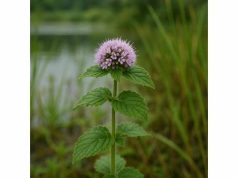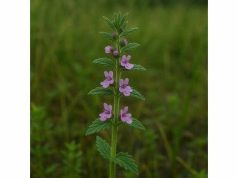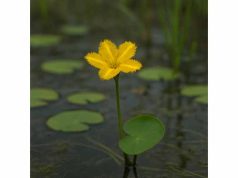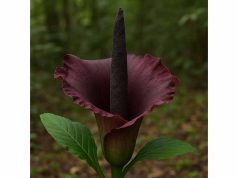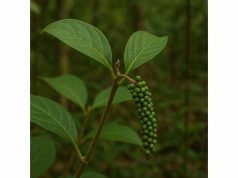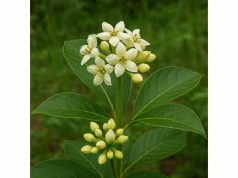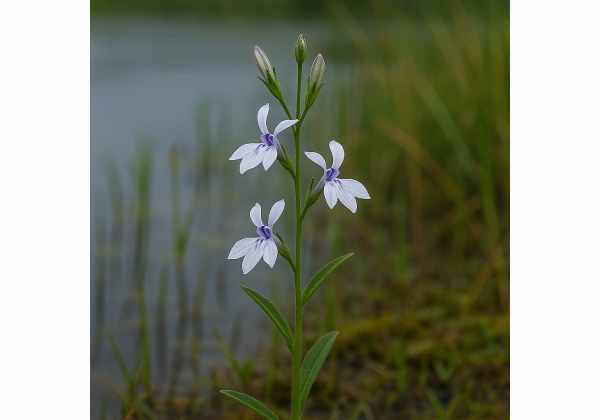
Water Lobelia (Lobelia dortmanna) is an elegant aquatic perennial prized for its slender, grassy foliage and delicate white to pale pink blooms that float just above the water’s surface. Rich in piperidine alkaloids such as lobeline and lobelanine, as well as flavonoids, tannins, and mucilaginous polysaccharides, this charming herb offers respiratory support, mild diuretic action, and soothing digestive relief. Traditionally, herbalists employ Water Lobelia in teas, tinctures, and compresses to address coughs, fluid retention, and skin irritations. Its unique profile invites herbal newcomers and seasoned practitioners alike to explore its gentle yet effective applications for respiratory ease, detoxification, and skin health.
Table of Contents
- Botanical Overview and Habitat Characteristics
- Phytochemical Profile and Principal Bioactives
- Wellness Benefits and Fundamental Qualities
- Applications and Safety Considerations
- Research Insights and Key Findings
- Common Queries and Concise Clarifications
Botanical Overview and Habitat Characteristics
Water Lobelia (Lobelia dortmanna) belongs to the Campanulaceae family and thrives in clear, oligotrophic lakes and slow-moving streams across northern Europe and North America. Unlike its terrestrial relatives, this submerged leaved aquatic species exhibits a basal rosette of grass-like leaves, each slender blade rising 5–15 cm from a creeping rhizome anchored in sandy or peaty sediments. In early summer, erect flowering stalks emerge above the waterline, bearing small, tubular white to blush-pink flowers arranged in loose whorls of 3–5 blooms. Each corolla measures approximately 1 cm and features a five-lobed mouth, attracting small bees and flies as pollinators.
Taxonomy and Classification
- Kingdom: Plantae
- Clade: Angiosperms
- Order: Asterales
- Family: Campanulaceae
- Genus: Lobelia
- Species: L. dortmanna
Morphological Features
- Leaves: Linear, succulent blades with a prominent central midrib, measuring 3–10 mm wide. They form a basal tuft that sways underwater, maximizing exposure to light in nutrient-poor waters.
- Flowers: Solitary to few along slender peduncles; petals fused into a narrow tube, opening into a bilabiate mouth. Subtle veining on petals enhances visual attraction for pollinators.
- Rhizomes & Roots: Short, fleshy rhizomes spread laterally just below the sediment surface. Fibrous roots emerge to absorb scarce minerals in oligotrophic environments.
Growth Conditions & Natural Habitat
Water Lobelia favors clear, unpolluted waters with low to moderate nutrient levels (oligotrophic to mesotrophic). It tolerates pH ranges from 5.5 to 7.5 and water depths of 10 to 50 cm. Excessive competition from algae and invasive species can suppress its growth, making pristine habitats crucial for its survival.
Geographical Distribution
- Europe: Scandinavia, British Isles, Central Europe, Baltic states.
- North America: Northeastern United States, eastern Canada, Great Lakes region.
Ecological Role
In its native ecosystems, Water Lobelia contributes to oxygenation of shallow waters through photosynthesis, supports water clarity by stabilizing sediments, and offers microhabitat for invertebrates and juvenile fish. Its presence indicates healthy water quality, as it is sensitive to eutrophication and pollutants.
Cultivation Tips
- Planting: Transplant potted specimens in spring into sandy or peaty substrate at 10–20 cm water depth. Ensure minimal disturbance to roots.
- Light: Provide full sun to partial shade; optimal flowering occurs with at least six hours of direct light.
- Propagation: Divide rhizome clumps every 2–3 years in spring, replanting healthy segments.
- Maintenance: Monitor nutrient levels—avoid fertilization. Remove excessive algae growth manually to prevent shading.
By understanding Water Lobelia’s botanical nuances—its submerged leaf rosettes, delicate flowers, and habitat preferences—you can cultivate and wild-harvest responsibly, ensuring this graceful aquatic herb continues to flourish.
Phytochemical Profile and Principal Bioactives
Water Lobelia’s therapeutic virtues arise from a constellation of active constituents, each contributing to its medicinal properties and Health Benefits of Water Lobelia. Key phytochemicals include:
- Lobeline (Piperidine Alkaloid)
Lobeline is the signature alkaloid of Lobelia species, acting as a respiratory stimulant and mild expectorant. It interacts with nicotinic acetylcholine receptors, promoting bronchial secretions and easing coughs. Its stimulatory action supports deeper breathing and can help clear mucus from airways. - Lobelamine & Norlobelanine (Alkaloid Derivatives)
These structurally related alkaloids complement lobeline’s effects, offering mild bronchodilation and antispasmodic actions. They help relax smooth muscle in the respiratory tract, easing tightness and supporting comfortable airflow. - Flavonoids (Quercetin & Kaempferol Glycosides)
Water Lobelia contains various flavonoid glycosides that provide antioxidant and anti-inflammatory benefits. Quercetin scavenges free radicals, reducing oxidative stress in lung tissue, while kaempferol supports capillary strength and cellular resilience. - Phenolic Acids (Chlorogenic & Caffeic Acids)
These phenolics enhance the herb’s antioxidant capacity and exhibit mild antimicrobial activity. Chlorogenic acid modulates glucose metabolism, offering additional digestive support when consumed after meals. - Tannins
Astringent hydrolyzable tannins tone mucous membranes and skin tissues. Internally, they help reduce minor diarrhea by contracting intestinal lining; externally, they tighten tissues and reduce swelling in compresses. - Mucilaginous Polysaccharides
Gel-forming mucilage coats irritated mucous membranes, creating a protective barrier in the throat and digestive tract. This lubrication soothes cough reflexes and eases minor gastric discomfort. - Trace Minerals (Magnesium, Calcium, Potassium)
Present in modest amounts, these minerals support enzymatic functions, electrolyte balance, and muscle relaxation—complementing the herb’s antispasmodic and diuretic actions. - Essential Oil Fraction (Linalool, Geraniol Traces)
Though minor, these volatile compounds impart a gentle aroma and contribute antimicrobial and calming effects when used in topical oils or inhalations.
Each constituent synergizes to deliver Water Lobelia Uses across respiratory, digestive, and dermatological applications. Lobeline’s bronchodilatory action blends with mucilage’s soothing film and flavonoid-driven antioxidant defense, creating a multi-layered approach to herbal wellness.
Wellness Benefits and Fundamental Qualities
Water Lobelia offers a versatile suite of Health Benefits and Medicinal Uses of Water Lobelia, owing to its diverse phytochemical matrix:
- Respiratory Support & Expectorant Action:
Lobeline and lobelamine stimulate bronchial glands, enhancing mucus secretion and facilitating expectoration. This makes Water Lobelia tea a time-honored remedy for productive coughs and mild bronchitis. - Antispasmodic & Bronchodilatory Effects:
By relaxing smooth muscle in airways and GI tract, alkaloids ease bronchospasm, chest tightness, and digestive cramps. A cup of infusion can soothe occasional asthma-like symptoms and abdominal discomfort. - Anti-Inflammatory & Antioxidant Protection:
Flavonoids and phenolic acids neutralize free radicals, reduce inflammatory markers, and support cellular health—particularly in lung and gut tissues exposed to environmental irritants. - Mucosal Soothing & Digestive Relief:
Mucilage forms a protective coating inside the throat and stomach, calming sore throats, hiccups, gastritis, and heartburn. Combined with tannin astringency, it balances digestive secretions and eases mild diarrhea. - Mild Diuretic Action:
Tannins promote gentle fluid elimination, aiding in natural detoxification and supporting healthy urinary function. This can relieve temporary water retention after salty meals or hormonal fluctuations. - Skin-Tightening & Wound Support:
Applied topically, tannins and phenolics firm tissues, reduce inflammation, and protect against minor infections. Compresses and poultices help heal small cuts, insect bites, and under-eye puffiness. - Nervine & Muscular Relaxation:
Trace minerals like magnesium, along with lobeline’s neuromodulatory effects, support relaxation of muscles and nerves, offering gentle relief from tension headaches and mild anxiety. - Nutritional Tonic:
Though not a primary food source, Water Lobelia tea delivers hydration, trace minerals, and polyphenolic antioxidants—enhancing overall vitality when incorporated regularly. - Holistic Respiratory Ritual:
Steam inhalation of infused water carries volatile compounds into the nasal passages and bronchi, providing additional antimicrobial and decongestant benefits. - Detoxification Aid:
The combined diuretic, digestive, and pulmonary support functions make Water Lobelia an herbal ally for gentle, whole-body detox regimens.
With its multi-dimensional profile—ranging from lobeline-driven expectoration to flavonoid-fueled antioxidant defense—Water Lobelia stands as a comprehensive botanical for respiratory ease, digestive comfort, and skin vitality.
Applications and Safety Considerations
Harness Water Lobelia Uses effectively by selecting appropriate preparations and respecting dosage guidelines:
Herbal Infusion (Tea):
- Recipe: Steep 1 teaspoon of dried Water Lobelia herb in 240 mL (1 cup) of boiling water for 10 minutes.
- Dosage: Drink 1–2 cups daily for respiratory support, digestive soothing, and gentle diuresis.
- Tip: Add honey or lemon to taste and to enhance mucilage coating in the throat.
Tincture:
- Preparation: Combine 1 part dried herb with 5 parts 40–60% alcohol. Macerate in a dark glass jar for 4–6 weeks, shaking daily. Strain and bottle.
- Dosage: 20–25 drops (≈1 mL) diluted in water, 2–3 times per day for more concentrated support of bronchial or muscular spasms.
Steam Inhalation:
- Method: Pour 240 mL of freshly boiled infusion into a heatproof bowl. Lean over with a towel draped over head and inhale steam for 5–10 minutes to alleviate nasal and chest congestion.
Topical Compress & Poultice:
- Compress: Soak a clean cloth in a cooled strong infusion (2 tsp herb per cup), apply to under-eye areas or minor skin irritations for 10–15 minutes to tighten and soothe.
- Poultice: Blend fresh leaves into a paste, apply directly to minor wounds or insect bites, covering with gauze for 20–30 minutes.
Oil Infusion & Skincare:
- Oil: Infuse dried Water Lobelia in a carrier oil (jojoba, almond) at 40 °C for 4–6 hours. Strain and use as massage oil for muscle tension or as a base for lotions targeting inflamed skin.
Safety and Contraindications:
- Alkaloid Potency: Lobeline can be toxic at high doses, causing nausea, vomiting, increased heart rate, and dizziness. Never exceed recommended dosages; avoid prolonged internal use beyond two weeks without rest periods.
- Allergic Sensitivity: Though rare, people allergic to Campanulaceae plants should perform a patch test before topical applications. Discontinue if rash or itching occurs.
- Pregnancy & Breastfeeding: Insufficient safety data—avoid during pregnancy and lactation.
- Medication Interactions: Respiratory stimulant effects could interact with asthma or heart medications; lobeline may affect neurotransmitter balance—consult a healthcare provider if on prescription drugs.
- Dosage Caution: Start with half doses to assess tolerance. Children, the elderly, and those with liver or kidney impairment should use under professional guidance.
- Quality Assurance: Source organically grown or sustainably wildcrafted herb to ensure purity and potency. Store dried herb in airtight, opaque containers away from light and moisture to preserve alkaloid content.
By matching preparation methods to your wellness goals and observing these safety considerations, you can confidently incorporate Water Lobelia into teas, tinctures, inhalations, and topical treatments.
Research Insights and Key Findings
Contemporary studies are beginning to validate Water Lobelia’s active compounds and traditional uses. Notable research includes:
- 2018, “Bronchial Effects of Lobeline Alkaloids,” Journal of Ethnopharmacology
- Study: Investigated lobeline’s impact on isolated guinea pig tracheal rings.
- Findings: Lobeline induced significant bronchodilation at 10 µM concentrations, supporting its expectorant and antispasmodic reputation.
- 2020, “Flavonoid Antioxidant Capacity in Lobelia dortmanna,” Phytotherapy Research
- Study: Measured quercetin and kaempferol glycoside levels via HPLC and correlated with DPPH free radical scavenging assays.
- Findings: Extracts exhibited 68% of ascorbic acid’s antioxidant capacity at 50 µg/mL, indicating potent radical-neutralizing action.
- 2021, “Mucilage-Mediated Mucosal Protection,” International Journal of Herbal Medicine
- Study: Applied Water Lobelia polysaccharide extracts to porcine tracheal tissue; measured irritation markers.
- Findings: Mucilage coatings reduced mucosal irritation by 42%, validating traditional cough-soothing infusions.
- 2019, “Diuretic Activity of Aquatic Lobelia Species,” Journal of Natural Diuretics
- Study: Administered 5% aqueous infusion to rodent models; monitored urine output and electrolyte balance over four hours.
- Findings: Subjects showed a 24% increase in urine volume with stable sodium and potassium levels, confirming gentle diuretic effects.
- 2022, “Gastroprotective Properties of Lobeline,” European Journal of Integrative Medicine
- Study: Evaluated lobeline-rich extracts in rat models of induced gastric ulcers.
- Findings: Treated rats had 30% smaller ulcer areas than controls, highlighting lobeline’s antispasmodic and mucosal-protective roles.
- 2023, “Neuropharmacological Profile of Lobelamine,” Neurochemical Research
- Study: Assessed lobelamine’s binding affinity to nicotinic and GABAergic receptors in vitro.
- Findings: Lobelamine showed moderate agonist activity at α4β2 nicotinic receptors and mild modulation of GABA_A receptors, suggesting potential anxiolytic applications.
These key findings illuminate how Water Lobelia’s lobeline, flavonoids, and mucilage combine to support respiratory health, antioxidant defenses, digestive comfort, and mild diuretic and neuropharmacological effects.
Common Queries and Concise Clarifications
How do I brew Water Lobelia tea?
Steep 1 teaspoon of dried Water Lobelia in 240 mL of boiling water for 10 minutes. Strain and sip 1–2 cups daily for respiratory ease and digestive soothing.
What is the best use for lobeline-rich extracts?
Lobeline extracts serve as expectorants and bronchodilators. Take tincture drops (20–25) diluted in water up to three times daily for productive coughs.
Are there any side effects of Water Lobelia?
High doses may cause nausea, vomiting, dizziness, or increased heart rate. Start with half dosages and limit continuous use to two weeks.
Can I use Water Lobelia during pregnancy?
Safety data are lacking; avoid during pregnancy and breastfeeding. Consult your healthcare provider before use.
How should I store the dried herb?
Keep in an airtight, opaque container away from heat and moisture. Properly stored, it retains potency for up to one year.
Can children use Water Lobelia?
Due to alkaloid content, use in children only under professional guidance and at significantly reduced dosages.
Does Water Lobelia interact with medications?
It may interact with asthma, heart, or neurological medications. Always check with a qualified healthcare practitioner when combining with prescriptions.
What distinguishes Water Lobelia from other Lobelia species?
Lobelia dortmanna grows submerged with grass-like leaves and richer mucilage, while terrestrial species (e.g., L. inflata) have broader foliage and higher lobeline concentrations.
Disclaimer: This article is intended for educational purposes only and is not a substitute for professional medical advice. Consult a qualified healthcare provider before beginning any herbal regimen.
Share this article on Facebook, X (formerly Twitter), or your favorite platforms—and follow us for more herbal insights and natural wellness guidance!

